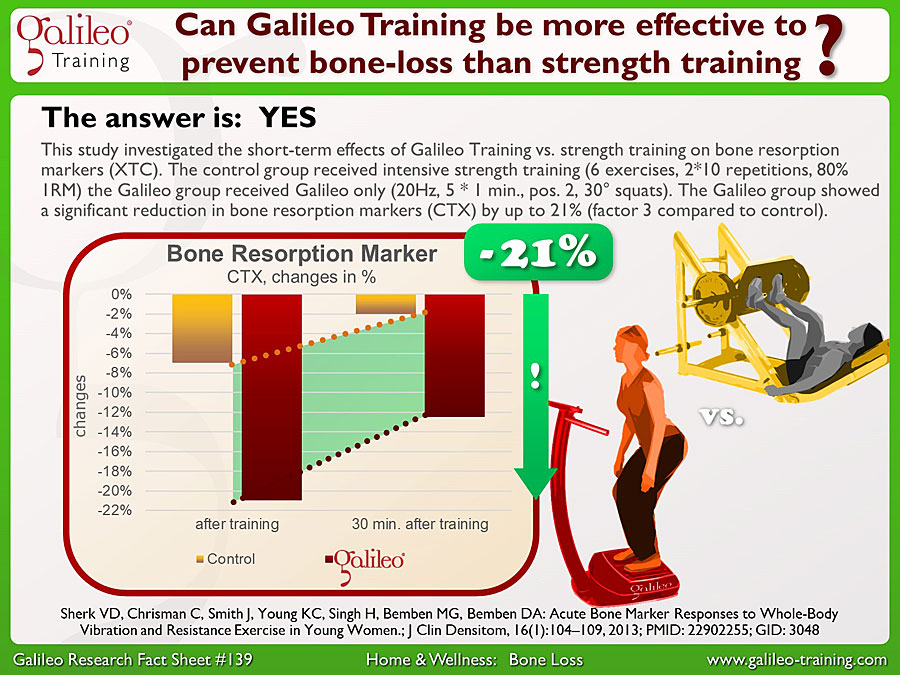This Study observed short-term effects of Galileo Training on Postural Control compared to traditional balance training (25Hz, pos. 2, 2 min., almost straight leg, on forefoot). The Galileo group showed better results than the Wobble-Board group. The combination of reduction of co-contraction (-18%) and of H-Reflexes (-31%) resulted in an significant improvement of Postural Control (covered balance area -8%)...
Galileo Research Facts No. 151: Can Galileo Training make squats more efficient and more effective?
This study reported the short-term effects of Galileo Training on muscle activation and exhaustion (26Hz, 90° dynamic squats, Pos. 6, 40% body weight extra load, subjective exhaustion). The control group received identical exercises without Galileo. The Galileo groups showed higher training effects (increase lactate +205% instead of +160%) in significantly shorter time (349s instead of 515s) plus increased muscle activation...
Galileo Research Facts No. 149: Can Galileo Training significantly increase force and force development?
This study investigated the short-term effect of Galileo Training on force and force development (26Hz, 40° squat, Pos. 3, 5Min). The control group received identical exercises without Galileo or cycling ergometer (70W). Force and force development during electrostimulation was measured. While both control groups reduced the parameters 5 minutes of Galileo Training could increase force and force development significantly...
Galileo Research Facts No. 147: Can Galileo Training compensate the effects of bedrest on the Bone Marrow Fat-Fraction?
In the 2nd Berlin Bedrest Study (BBR2) the effects of Galileo Training against the expected bone loss was tested (55 days, 24Hz, 6x1 min. exhaustive, 3/week). The control groups receive no training or identical training with-out vibration (RE). Compared to both control groups, the Galileo group showed a decrease in vertebra bone marrow fat fraction and in increase in number of red blood cells - both are related to increased endurance...
Galileo Research Facts No. 146: Can exercises with extra loads and with Galileo Training at 40Hz be more effective than without?
This study investigated the effects of squats and heel raises with extra loads on muscle function and cross-section with and without Galileo Training at 40Hz (20-40Hz, pos. 3-4, loads 80% 1RM (80kg), 3x8 squats (4 sec.), 3x12 heel raises, 6 weeks, 16 Sessions). The Galileo Group showed higher training effects with increases of isometric torque (up to +4%) and the speed indicator reactive ground contact time (-8%, Drop Jump)...
Galileo Research Facts No. 145: Can Galileo Training compensate negative vascular effects of bedrest?
In the 2nd Berlin Bedrest Study (BBR2) the effects of Galileo Training against the expected bone loss was tested (55 days, 24Hz, 6x1 min. exhaustive, 3/week). The control groups receive no training or identical training with-out vibration (RE). While the control groups showed significant decrease in vascular parameters like dilator capacity or vascular diameter, the Galileo Group could even improve some of them (Vascular Stiffness)...
Galileo Research Facts No. 143: Can Galileo Training over a period of 12 weeks increase bone density at the spine?
This study investigated the effects of 12 weeks of Galileo Training on bone formation markers and bone density of the spine in physical active students (age 18-23) (15-26Hz, 5-15 min., pos.2, 3/week, 12 weeks). The control group did not receive any additional exercises. While the control group decreased bone density at the spine of by up to 1.7%, the Galileo group could increase the bone density at the spine by up to 2.7%...
Galileo Research Facts No. 141: Can Galileo Training be more effective and more efficient than traditional stretching?
This study documented the immediate effects of Galileo Training one force development, torque and range of motion (ROM) (26Hz, 5x60s, stretching of ankle). The control group performed identical exercises without Galileo Mechanostimulation. The Galileo group showed increase stretching effects (+38%) and a significant increase in torque (Platarflexion) by +18%, and an increased force development at lower ankle angles (-7°)...
Galileo Research Facts No. 139: Can Galileo Training be more effective to prevent bone-loss than strength training?
This study investigated the short-term effects of Galileo Training vs. strength training on bone resorption markers (XTC). The control group received intensive strength training (6 exercises, 2*10 repetitions, 80% 1RM) the Galileo group received Galileo only (20Hz, 5 * 1 min., pos. 2, 30° squats). The Galileo group showed a significant reduction in bone resorption markers (CTX) by up to 21% (factor 3 compared to control)...
Galileo Research Facts No. 137: Can Galileo Training be more effective and efficient for warm-up than ergometer training?
This study investigated the warm-up effects of Galileo Training on muscle temperature, power and the training duration. Passive warm-up in a water bath (legs at 41°C), standard ergometer training (10 min., 70W) and Galileo Training (26Hz, Pos.3,10°-90° 6s slow dynamic squats, 5min.) where compared. The results showed that Galileo Training had higher effects on muscle power (ergometer) in a shorter time (52% of ergometer)...









